Around the turn of the millennium you could buy a new V6 Commodore for circa $43k. Nowadays, the top of the range Mazda3, the car you see here, costs $47,495 and it’s two classes down. However, its specification and safety package is through the roof and it would give the V6 Commodore a run for its money in a drag race.
Both are normally aspirated but the norm now, at least for the top of the range performance models, is turbocharging and the SP25 Limited’s natural adversary is another Limited, this one the top of Hyundai’s new i30 range, the 1.6T Limited. With a direct-injection engine and a wee blower, the little 1.6 four generates 150kW and 265Nm, the latter available from 1500rpm. Mazda, eschewing turbocharging wherever it can (but progressively introducing forced induction in selected models) counters with a long stroke 2.5L naturally aspirated four that cannot quite match the i30’s output though is only a handful of units behind.
It’s torque peak occurs at precisely twice the revs of the i30’s. Where it does gain an edge, however, is claimed fuel economy, the Hyundai rated at 7.5L/100km overall, and the Mazda at 6.0L/100km. The latter is happy gulping (or not) 91 ULP whereas the i30 likes the higher octane beverage. However, in this swings and roundabouts saga, the i30 is less expensive at $43,990, a saving of $3500 odd. You get a bit more spec, three years of free servicing and a five-year warranty with the Mazda (i30’s is three years) so which is the better buy overall?
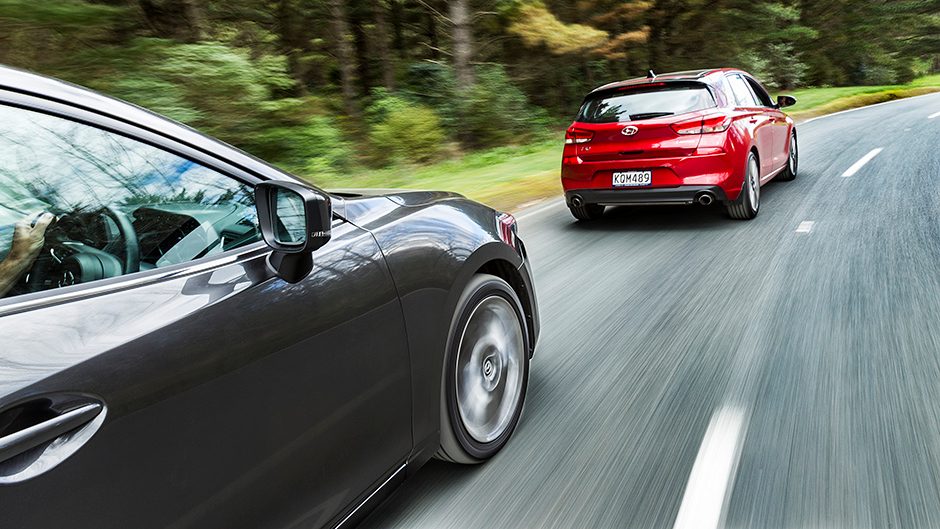
Given how close they are in specification we shall leave that until last and crank on with the bits you’re probably most eager to know about. We’ve always rated the SP25, and had a memorable drive in a six-speed manual earlier in the year; it’s one of those cars that gets under your skin. If you’re just sloping around town in Normal mode, you might get the sense this isn’t anything special, the engine whiny when cold, and the suspension a touch firm in slow going but get it warmed up, head out beyond the daily grind, hit Sport mode, and it takes on another persona.
Mazda has persevered with normally aspirated engines, quietly fettling them and it shows here. The auto performs almost as well as the manual transmission, both six-speeders, particularly with the options it offers. There are paddles affixed to the wheel, there’s a manual sequential slot for the shift lever and it comes in for plenty of use because it is oriented correctly (forward to downshift).
In Sport mode the transmission likes to hold gears longer so the engine is buzzing away in fourth at 100km/h if you don’t take over the reins yourself. Not that you hear it whirring, but it can’t be good for fuel efficiency. Even so, this is surprisingly decent on the whole. It’s also one reason why people might consider a downsize from the much bigger Mazda6. Sure, it doesn’t quite compare with the manual for economy and that failed to shift out of single figures on much the same test drive loop, but then a high in the tens is hardly anything to be ashamed of either.
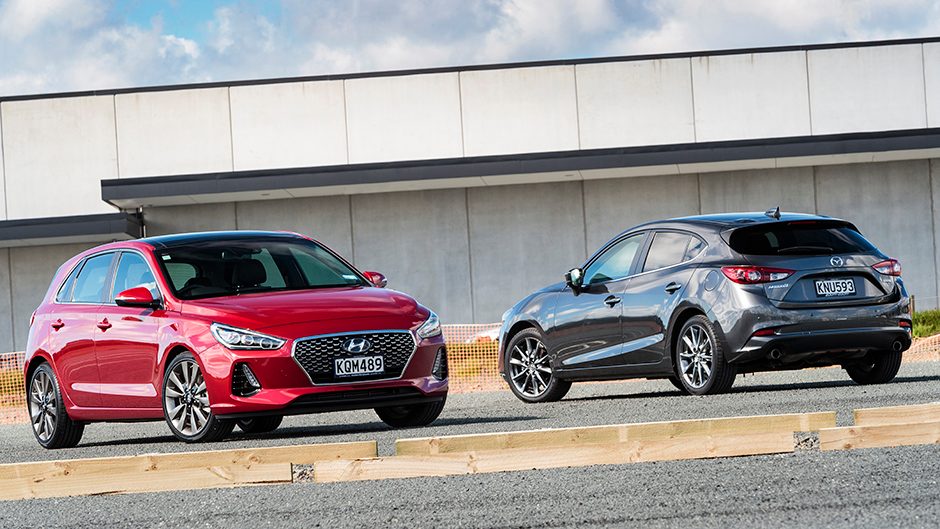
The i30, being turbocharged was 50 per cent thirstier at its worst but then it’s a turbo and it compensates in other ways. Like, for instance, despite being a heavier car by roughly 50kg, and having a soggy launch (it wouldn’t spin up on the brake to anything more than 1800rpm, presumably to prevent ridiculous amounts of wheelspin) it proved quicker by almost a second 0-100km/h (6.75 vs 7.65sec).
Things were much closer on the overtake but it still had the wood over the Mazda, a 4.39sec best shading the SP25 by roughly 0.3sec. Helping the i30’s cause is a fast-shifting seven-speed twin-clutch transmission. It’s not the slickest in terms of sheer pace between cogs, but it compensates by being smoother on the uptake from standing starts than some, and not running backwards unnervingly when attempting hill starts.
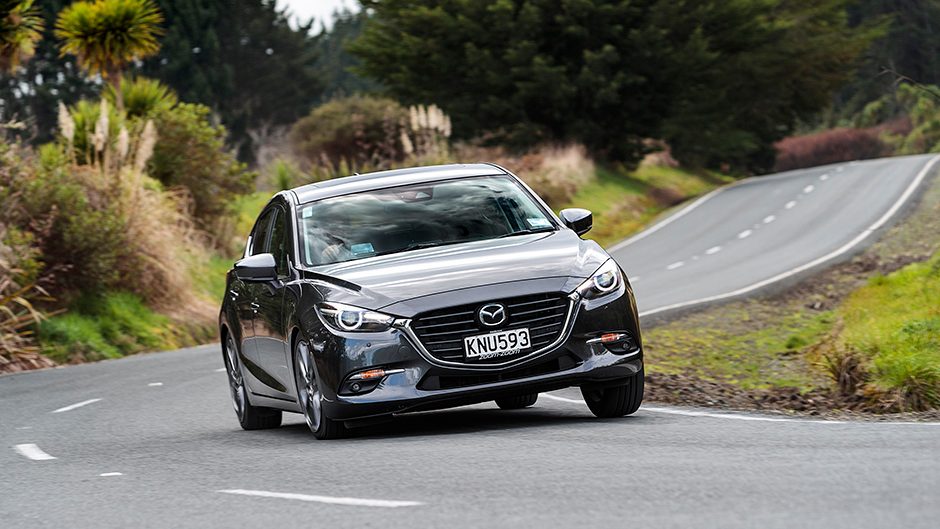
As to the engines themselves, they’re both an absolute delight, but in this instance we’d opt for the atmo mill. Why? It is surprisingly similar in terms of tractability. Both haul away with intent from about 1500rpm, and are effortless in higher gears about town. The low-down grunt comes naturally to the turbo but because of its sheer displacement (and design) the torque also chimes in early in the Mazda.
On rural byways both are seriously into their stride from about 2500rpm, and each works well in Normal mode; you’re not automatically searching for Sport from the outset. The Mazda defaults to Normal each time you kill the ignition anyway. But hit the Sport button and extra life that had been in hiding is instantly on tap, and it’s all a bit addictive. Revel in the torque that lies between 2500 and 4000rpm – the peak arrives at just over 3000rpm – or make use of the torque and top end power that’s delivered from about 3500rpm onwards.
The i30 with its surfeit of low-down grunt tends to shift into higher gears as soon as possible in Normal mode so perversely doesn’t feel quite so go-get-’em-Tiger as the Mazda in the same setting. Shift to Sport and you instantly notice more heft and resistance at the helm, and it feels a bit overdone most of the time. Perhaps it wouldn’t be so bad if the electric mechanism was less artificial in its weighting but we kept returning to Normal mode to avoid this.
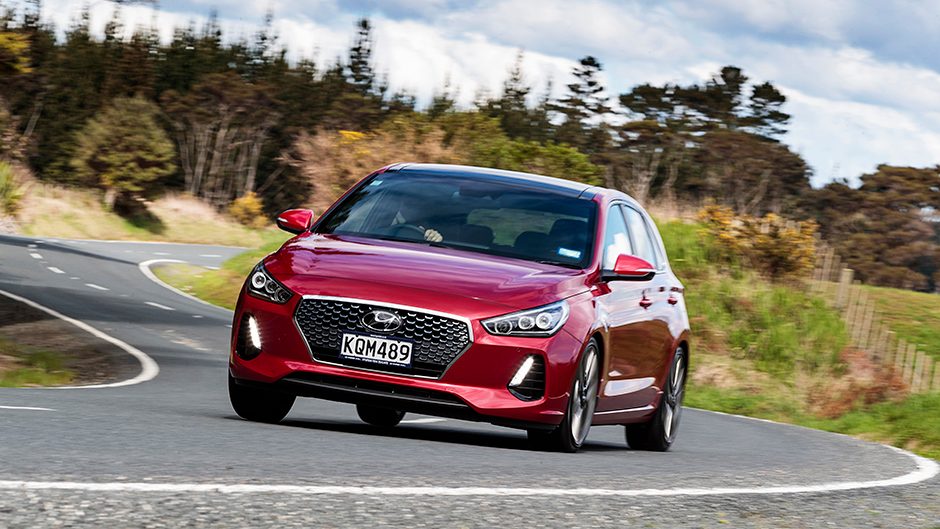
That is one of the primary differences between the i30 and the Mazda. There’s a lot of road surface information making it back to the helm of the i30, partly because of its lower profile rubber, but this doesn’t constitute steering feel. It becomes a bit tiresome after a while. Turn the wheel off centre and there’s not much indication of where the wheels are at; the Mazda does this better, and doesn’t have the strange electric weighting artifice of the Hyundai helm, nor the chatter of chip seal. It makes it more fun to guide down a winding road too.
Not that the firmer sprung i30 isn’t a bit of a blast in the same situation; it corners in fast and flat fashion, its extra footwear a help (though a slight hindrance in terms of road noise generated; 73.0 versus 71.8db for the Mazda). And it turns quickly enough too, though we feel the new G-Vectoring Control of the Mazda helps it turn even sharper. Another factor that gives the SP25 the edge is its better suspension compliance.
So it doesn’t corner as flat but it does mop up the road irregularities slightly better, while the SportMaxx TTs still hang tough. Being quieter overall, it makes it the better touring option.
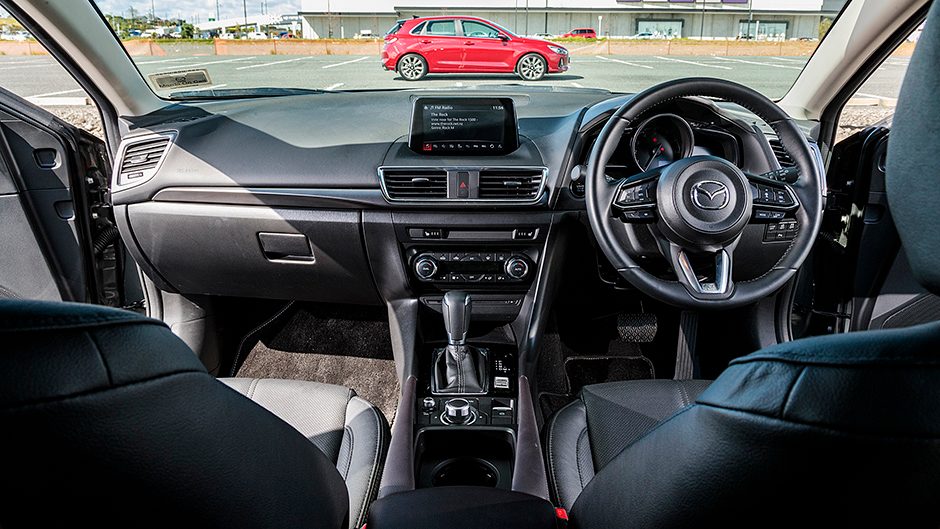
It may be a more conservative shape the i30, without the wavy character lines or swooping roof that make the SP25 look so interesting in profile, but the newer car comes with a flasher interior. With two-tone highlights in vermillion, a red instrument background and racy double stitching, the i30 features the faster interior, but the Mazda ergonomics are better and they’ve always been a highlight in the 3.
I even came to appreciate their little head-up display, which now shows speed limits, cars approaching in your blind spot, active cruise settings and such. Set up and angled properly using the clever, well considered mouse controller, it’s a real asset. There’s not quite so much in the way of contrasting finishings in the Mazda, unless you call the mildly contrasting purple and black leather upholstery flash. “It looks like a mistake”, said the missus. “Perhaps in a different light”, I suggested.
There’s restrained use of chrome. The luggage space is a win to the i30, its 395L hold dwarfing the SP25’s 308L area. Mazda’s floor is set higher to ensure a flat 1222L load space after rolling the rear seat back over. The i30’s is a two-tier affair, but then how often do you use that? I’d rather the more practical hatch space. For rear seat passengers, there’s more headroom in the car with the swoopier roofline so go figure once again.
Otherwise they’re much the same in the back seat area. A larger rear window makes it a bit easier to see following traffic in the i30 but given most Kiwis never bother checking what’s behind them that’s not really relevant.
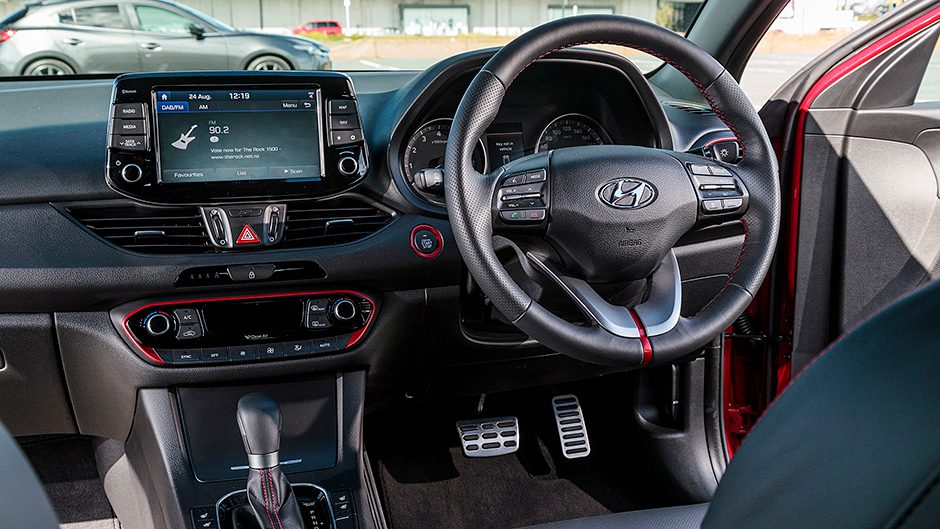
As to specification, we’ve already touched on the differences, and there really aren’t all that many of note. The Mazda’s handy head-up display is countered by a digital speed readout in the i30. We like the simplicity of the trip data in the SP25; there’s revs and speed in the central readout, and basic trip data alongside, with speed repeated in the HUD.
The Mazda has an efficient stop-start mechanism that’s missing in the i30, and a couple of seat memories. They both share dual zone air, sat nav, a powered sunroof, active cruise, blind spot and lane departure warnings, and autonomous braking. Each has leather clad powered and heated seats, but the i30 adds ventilation. Powered lumbar support is common to each. The i30 also has a phone charger for Android devices. SP25 gets a mouse controller, the i30 a touch screen. Both work well.
Overall, the i30 is quicker and cheaper, but thirstier and doesn’t balance ride and handling quite so well as the more expensive SP25. Nor is it as sassy to behold. Given the Mazda SP25 can be had in un-Limited form from $39,895 in sedan or hatch auto formats whereas the other i30 is the 2.0L Elite 6A at $39,990, we’d pick the Mazda3 in this instance.
| Model | Hyundai i30 1.6T Limited | Price | $43,990 |
| Engine | 1591cc, IL4, T/DI, 150kW/265Nm | Drivetrain | 7D, FWD |
| Fuel Use | 7.5L/100km | C02 Output | 173g/km |
| 0-100km/h | 6.75sec | Weight | 1429kg |
| Model | Mazda3 SP25 Limited | Price | $47,495 |
| Engine | 2488cc, IL4, DI, 138kW/250Nm | Drivetrain | 6A, FWD |
| Fuel Use | 6.1L/100km | C02 Output | 140g/km |
| 0-100km/h | 7.65sec | Weight | 1372kg |


